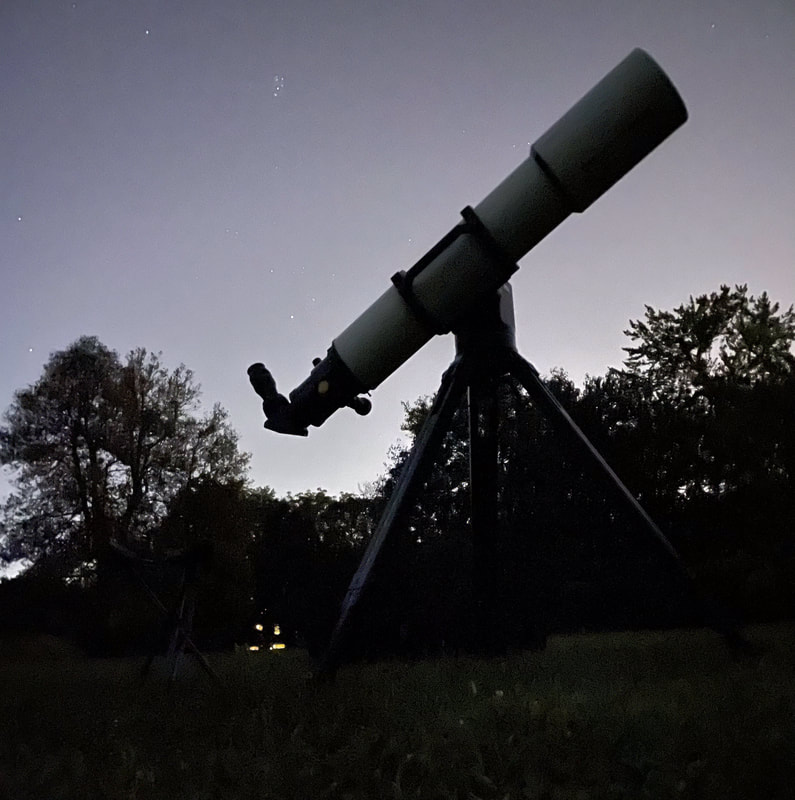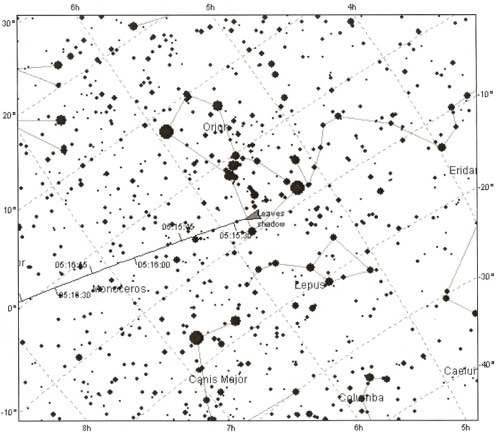|
Conditions were glorious last night - temperatures in teens, seeing and transparency both above average - and I was feeling surprisingly energetic, so I dragged my TEC 140, DM-6, and Berlebach Uni tripod out the door, and walked 15 minutes to my favorite nearby park. I had about 80 pounds of gear with me, but somehow, last night, I found it quite manageable. It was heartening to know that I could transport the TEC 140 without much more difficulty than I used to haul about my dearly departed APM 140.
When I set up shop I noticed that the sky was strikingly dark, and that the stars and planets scarcely twinkled. I immediately plugged in my highest-power Delos eyepiece - which manages 217x - and targeted Jupiter. What a view! I lost track of how many cloud belts I could make out, and subtle detail was everywhere. I was looking at the same hemisphere I had admired about a week ago with the TEC 140, and that same barge I noticed then was still around. Now the Galilean moons looked even more clearly like disks, and therefore like real little worlds. I decided that the difference between the TEC 140 and the APM 140 lies in the sensation of texture on the planets. More than the APM, the TEC gives me the feeling that the clouds of Jupiter, for example, have depth, which in turns makes it clearer that I'm observing a three-dimensional object. That really makes a profound difference. Both the APM and the TEC provide views that are far better than those of four-inch refractors, including the Takahashi FC-100DZ. There's just so much more contrast visible with the bigger refractors, and on a low-contrast object like Jupiter that means everything. The view of Saturn was a bit less perfect, just like it was a week ago. While I could easily crank up my magnification past 200x on Jupiter - which is usually about the limit in the Washington, DC air - Saturn benefitted from lower magnification. Still, I was struck by the obvious complexity of its ring system in moments of good seeing. It seemed I could clearly make out not only the Cassini division, but at times I got a flicker of brightness variations, attesting to distinct ring groupings of varying brightness. After observing Jupiter and Saturn for a while, I wheeled the telescope east to observe the Pleiades at low magnification, which was pleasant but not noticeably different than it is in a smaller refractor. Then I realized that Uranus had climbed well over the horizon, and in fact that it should now be near 37 Ari, a star of very comparable magnitude (5.75 to 6 for Uranus). I've never observed Uranus before. I've tried to find it, but come up empty time and time again. It's actually a little embarrassing; it shouldn't be that hard to identify. So, this time, with the weather perfect and armed with a powerhouse telescope, I decided to give it a try. The trick was to find Menkar (Alpha Ceti) and Kaffaljidhma (Gamma Ceti) in the constellation Cetus. While these are bright stars - Menkar in particular, at magnitude 2.5 - it's telling that even with atmospheric transparency better than average, I could only barely make them out. DC's light pollution is especially bad to the southeast from my position, which is where the national mall and the rest of the city's downtown area is located. Anyway, once I found those two stars I used them to triangulate Mu Ceti, which at magnitude 4.25 truly was at the edge of my perception. These three stars in Cetus formed a narrow triangle that pointed to Uranus and 37 Ari. In fact, the length of the triangle was actually greater than the distance of the planet from that triangle. Using my finderscope, I searched. And searched. About 20 minutes went by, and no dice: I could see only stars. I started scanning more broadly, thinking I'd done something wrong. Then I checked my star map - which I get through an app called Stellarium - and suddenly it hit me: I'd been looking for something that looked like a planet. But Uranus is so far away - and therefore so dim - that it should really be indistinguishable from a star at low magnifications. My problem was that I had plugged in my 24mm Panoptic eyepiece, which gave me a magnification of just about 40x. I needed to trust my map and really crank up the power on the star that, I knew, must be Uranus. So I did. With the high power Delos eyepiece back in and my magnification at 217x, suddenly the planet became obvious: a little grey-green ball, wandering through space. I could make out, at most, only the subtlest detail on that little ball - and really it was virtually featureless. But the thought that that ball was four times the diameter of Earth gave me a rare, visceral sense of the scale of the Solar System. It can be hard to wrap your mind around the reality that the distance between Uranus and Saturn is actually greater than the distance between Saturn and the Sun. Now, at the eyepiece, it seemed obvious. I hadn't found Uranus before because I'd underestimated the size of the Solar System; I didn't imagine that a planet so big could look so small. It might seem like a drawback of manual mounts that it took me over 20 minutes to find Uranus - not to mention the many times I've searched for the planet and failed. Nothing could be further from the truth. When you do "star-hop" successfully with a simple mount, the sensation of actually finding what you're looking for is really special, and you don't get that with a go-to mount. You also start to genuinely learn the sky; I'd never thought about the constellation Cetus, for example, but now I know where it is, and I know that its third-brightest star is actually a triple-star system that I'd like to check out someday. That's not to say that star-hopping is always feasible or desirable, especially in the big city. But, as usual, you do give something up by opting for the convenience of modern technology. A last note on equipment: in recent days, I've ranked the Delos eyepieces, TEC 140, Orion 6x30 finder, DM-6, and Berlebach Uni tripod in comparison with other gear I've used. I've described them as the best I've seen in their class of equipment. Yet I haven't mentioned how well they all fit together. It really is seamless. The DM-6 holds the TEC 140 with perfect ease; there are no jitters, just buttery smooth movement even at high magnifications. The Uni tripod, while light, is an absolute rock, while the finder scope makes it a breeze to hop between stars. And the Delos eyepieces slotted in the TEC 140 provide a glorious view of just about everything. It's all very pricey, of course, but I really recommend this mix. The walk home was arduous. But, like William Herschel exactly 240 years ago, I'd found a new planet, and that made it easily worthwhile.
0 Comments
Leave a Reply. |
Archives
March 2024
Categories
All
|




 RSS Feed
RSS Feed